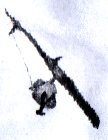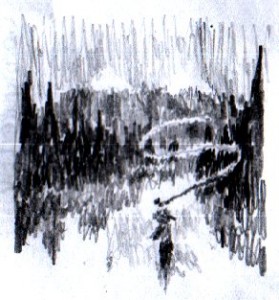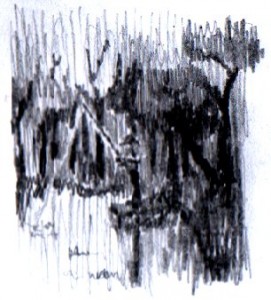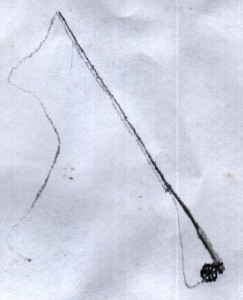I do not want to debilitate anyone or prevent them from fishing. I am not saying that regular fishing is ineffective or that it’s not even sometimes enjoyable. I like to fish with a spin rod in certain conditions, i.e. when there are no fly rods available, or when I am trolling for fish from the back of a cruise ship, yacht, or smaller vessel. Some types of fish don’t like to eat flies. That’s ok, there are other things you can put on your fly rod. But don’t worry, most fish like to eat flies.

The bottom of a spin caster fishing rod.
Ok, down to business. You’re waiting for a comparison between fly fishing and regular fishing. Regular fishing uses a spin rod, which is pictured to the right. I sketched one quickly from memory and my picture is almost completely accurate. You’ll notice that the handle is below the spinning mechanism. The line, which is just thin monofilament, wraps around a spool in the spinning mechanism. There is either a button you press or a little bar that you flip to release the line. If you swing the rod forward and release the line at the right moment the thing on the end of the line will go really far and land in the water somewhere. If the thing on the end is a live worm on a hook, then you just have to wait around for a fish to smell it then bite it. If you’ve got a lure on the end then you can reel it back in at varying speeds to try to attract the attention of some fish. In summary, you cast then reel, or cast then wait then reel.
Anyone who has tried the regular method knows that the really fun part is flinging the lure or bait into the right spot. Sometimes you just want to fling it really far out, and other times you want it to go between some stumps or lake-weed. The fun only lasts a moment, though, and then you’re back to waiting for a bite or spinning it back in right away. The time spent casting is probably only 4% of the total time spent fishing.
Fly fishing increases this ratio drastically, and even improves the quality and enjoyment of the cast. I know, it seems impossible, but it’s true. First of all, let me explain the setup of the fly fishing rod. As you can see to the left in the drawing of a fly-fishing rod, the handle is made of cork and is placed above the reel. The reel has no “release” button. Instead, the fisherman must pull out the line manually with the hand that isn’t holding the nice cork handle. As you can see from the picture, the line is much thicker than that of the spin caster rod. It is so thick, in fact, that its own weight is enough to cast itself. That’s why you can just put a comparatively weightless fly on the end of the line and still cast it around.
So how does a fly-fisherman cast the line without a release button? Does he just pull out a heap of line and then fling it in the right direction? No! Would there be any finesse in that sort of casting? No! Could he feel very good about himself, or would he enjoy fishing all day long if that were his method? No! No! Would that even work? Forget about it! To cast out the line he instead must fling out a little of the line, holding back the excess line with his free hand. Before the line touches the ground he has to fling it back behind him, letting out a little more line. Then he flings it forward, then back, and so on, letting out a little more line each time, all without touching the water, until it is long enough and he gives it one final flick, and the fly truly flies out far away into the water. It is verily a majestic process.
Have you ever seen a person with a basketball shooting hoops again and again, each time trying to work on his technique and improve it ever so slightly in order to drop the ball properly into the basket? Have you ever tried archery or knife-throwing, and found the temptation to hit closer to the target was too strong to resist another attempt? I tell you that fly fishing is the same. At the finality of each cast it is as though the rod and line are begging you, pleading with your arm which is holding the light cork handle, to fling it back up into the air and try the majestic flight of line and fly again.
The challenge and fun increase even more when fishing in a moving river, which is when fly fishing is usually utilized. The fisher must cast his fly in a certain location and wait for it to float over his target area. Then, instead of reeling in the line, he must skillfully fling it out of the water, and, in order to place it back to the beginning of his target area, he will have to fling it back and forth in different directions around him, so that besides reaching the right length, it will also achieve the correct angle. It is more challenging than basketball, less linear than archery, and the reward at the end could be a fish.

A rainbow trout.
Other Considerations

A fly fisherman in a typical setting. Notice the flowing river, the pine trees, and the snow-capped mountains.
Something else to think about is where you will be doing your fishing. If you are fly-fishing, you more than likely will be going to a refreshing fast moving river. There will be slippery stones, little waterfalls, bubbling brooks, and probably lovely snow-capped mountains and plentiful scented pine trees. The fish that you catch will be large and tasty, easy to clean and eat, like Silvers, Dolly Vardon, Rainbow Trout, or Salmon. Have you ever seen the side of a rainbow trout? It’s beautiful, a spectrum of colors, as you can see in my drawing of a trout above.

Yes, it is disgusting, he's fishing in a swamp with a spin-casting rod. He just got bit by a chigger.
But if you are fishing with a spin caster rod you will most likely be in some sort of little lake or pond. There will be pond scum piled up along the down-wind side of it, and water weeds will be reaching up all along the shore to wrap your hook. The trees will be crooked and full of snakes, and the grass around the edge will be overgrown and covered with ticks. The other people at the pond will probably be drunk and will get too excited about small catches. If you manage to catch a fish instead of twigs and soggy dead leaves, at best it will be a difficult-to-clean bass with only average-tasting meat. Otherwise you’ll get a spiny blue-gill or a tiny croppy or sunfish, with more bones than meat. Or maybe you’ll get a cat-fish, which are the giant floating worms with whiskers that eat scum and excrement from the bottom of the lake.
Conclusion
Oh no, don’t expect me to go regular-fishing anymore. Once a man goes fly-fishing, he only uses a spin-caster rod to be polite, because he takes no pleasure in it or its ways anymore. But don’t worry, spin-casting fishing is ok too, if that’s all you’ve got.
What to do if You’re a Spin-Casting Loser
There’s a really great fly-fishing rod, reel, and line setup that Cabela’s puts together. The parts are made by different brands and Cabela’s just combines them for you and gives you a good price. I would get the 9 foot four part rod, so it will fit into your suitcase when you happen to head to some place with a stream. There’s also the slightly cheaper Cahill Fly Rod and Reel Outfit from Cabelas that looks great for beginners. Don’t worry, you can also use it in lakes. Haven’t you ever smashed a horse-fly then thrown it onto the surface of the water? It doesn’t last long before some fish snags it from below. That’s how it will be on your lake when you use a fly-rod. Then you won’t have to use that tangled mess of a spin rod any more.


wow, you blow the “evils” of spin casting out of proportion. also, you make it sound like its impossible to wade with a spinning rod (it isn’t). this article is bad, and you should feel bad.
Great read, enjoyed greatly. There is something majestic about fly fishing thiugh I do both. I like the pictures as well. Thanks.
Don’t be fooled by the Fly Fishing story that it’s better than Spin Fishing!! Spin Fishing is by far the better, cheaper catch more fish than any fly fisherman way of fishing.. In fact I’ve frustrated many a fly fisherman with my spinning rod to the point of them walking out of the water and leaving because I was catching way more fish while they wore out their arm casting for nothing..Imagine if you were a fish?? Would you rather eat a little tiny thing made of thread and feathers or a nice juicy Butterworm or Wax Worm or Minnow?? If you were a Lion would you rather eat a fake bird made of feathers or a big juicy piece of meat?? I’ve sat and watched fly fisherman cast and cast and cast some more and not get a bite..fly fishing they say is an art and it may be.. but I’ll take my spinning rod and bait and many fish too.. any time of any day!!
My first suggestion would be that you attempt to work on your critical thinking skills in order to better convey your message. There is nothing wrong with expressing your passion for fly fishing or your reasons for liking it. However, your argument for fly fishing is rooted in an argument against spin casting. You paint a very inaccurate picture of traditional fishing. Why would you ever suggest that fly fishing takes place in beautiful clean streams, while spin casting takes place in dirty, undesirable ponds? This is a ridiculous statement that is propaganda at best and makes your entire argument null and void. Drifting in fast moving rivers with lures is a popular method of spin casters and wading is a part of that experience. As an avid fisherman, who uses both methods, I detest your thoughtless and inaccurate account of the differences. Both methods have their pro’s and con’s, while also having their own unique features and challenges.
This is pathetic, i use both methods, fishing in wild hill lochs in the heart of Scotland, these waters are clear, clean and even drinkable, and i will be honest i mostly spin fish, and as for the size and quality of fish you explain in your blog, thats a load of rubbish, we catch 5lb wild brown trout spin fishing on a regular basis, and the scenary is breath taking.
i thought the article was good.
I bow down humbly in the presence of such grtenaess.
Wow that is a very biased article. FYI I hammered rainbows and kokanees all summer out of a lake without catching a single leaf or twig. There may be more finesse involved in casting a fly but I bet I could jig/drift a worm or a leech and out-fish you 3:1 anyday.
NO you would not beat him every day especially if there is a hatch going on or later in the afternoon.
I found this article while searching for “Why casting lures is better than fly fishing”. I just returned from
a day at my favorite Pacific Northwest lake. As usual, I caught twice as many trout on lures than the
fly fishermen that were there. I can admire and appreciate the finesse of a good fly presentation, but I
really wonder how many “strikes” are actually FELT when fly fishing? The main attraction of fishing
with spinners and spoons for me is the moment of the strike when a fish slams my lure. That’s a rarity
in fly fishing, and for those who might not agree, I ask: then why do “strike indicators” exist? When I’m
casting lures, I’ve never had a need for a “strike indicator” – I feel every strike in my line, my rod, my hand,
my arm, and my shoulder! If I can’t have that experience with every fish, I might as well just be practicing
casting in my back yard…
You may be surprised to know that fly rods are generally more sensitive than any spin casting or spinning rod. The reason behind this is that you HAVE to feel every little nibble and bite in order to hook and land your fish, as well as that there is a general consensus that the best deserve the best, which is a 600$ sage rod. A spinning or bait casting rod doesn’t need that sensitivity simply because when the fish hit your lure, it is already in motion, practically setting the hook just by reeling. Simultaneously, the fish jerks away when the hook is still partially set, setting it more. By this moment you have realized you have your twelve inch trout on the line, so you set the hook hard enough to rip a koakanee’s lip off. Fly fishing is sometimes like this, but for the most part when a fish hits something, the fly fisherman sets that hook almost immediately, because of the extreme sensitivity of his rod. This also leads to fewer fatal wounds from a hook.
Additionally, strike indicators are generally used as a flotation device to suspend a nymph just about the riverbed. This same effect can be achieved by attaching a trailer hook with a prince nymph to the shank of a stimulator.
I hear and read lots of rhetoric from people who prefer one type of fishing over another. Why be so judgmental? Fly vs. Spin vs. baitcasting or even Center pinning (if you don’t know that last one Google it). Moving water, still water or shore, it’s all good. Respect and appreciate the nuances of each method and learn techniques so as to be a well-rounded angler. Fly fishing is my favorite method but I don’t look down upon someone who prefers to take a seat on the bank, cast out a worm and enjoy the outdoors.
Some very good writing and drawings, quite true and what an excellent sense of humor you have. Sad people didn’t get it. I fly fish for trout, my buddy spin fishes for large mouth bass. When with him on his favorite pond I once asked “Do you eat these?’. He replied “God no, these things are pigs, look at the filth they live in!”
Spin casting is just a low cast form of fishing, regardless of what is refected in the fisherman’s bank account. It’s just indicative of life spent taking the easy way out. It’s not about the amount of fish one catches but the style in which they are caught.
I’ve been fishing for 35 years. I think the things that you say are representative of ALOT of fly guys where I live. I live in the Rocky Mountains in CO. I learned to fish with a spin cast rod and a worm, moved to an open face reel, and I use baitcasters now for throwing lures. To me, fishing is about the correct presentation in the correct situation. Sometimes fly a work the best. But if I don’t have the room or to throw my fly rod, I don’t hesitate to put a bubble on with a fly. Granted, I don’t have the ability to change spots with reeling in, but it serves the same purpose as my fly rod in that situation. Yes, a bubble is not quite a stealthy presentation, but you learn to over cast and drag though the zone. Small bubbles work in rivers to…..on an open face. I like to fish for walleye and lake trout. There are some places I can hit walleye with flies, but I like to fish for Mackinaw and I use baitcasters (I don’t have a boat) with big lures. I guess what I’m trying to say is I think you’re missing the point of fishing all together. I laugh because when I fly fish I hear some of the same comments when it comes to the areas that fly fisherman are usually at and bass guys are in different areas. 90% of the people I know will readily eat walleye over trout any day. And we have some damn good trout where I live. Open your mind a little bit. I couldn’t imagine JUST flinfing for trout ALL the time. It would get boring to me. I bring a fly rod, an open face, and a baitcaster wherever I go. And I catch fish on all of them.
Tight Lines
Open Minds
Some people don’t get humor, or perhaps they can’t ‘read behind the lines’. When reading, “The trees will be crooked and full of snakes, and the grass around the edge will be overgrown and covered with ticks,” I burst out laughing! Excellent piece!
The author obviously enjoys fly fishing and has no appreciation of spin casting.
I always take a small ultra weight spinner rod and reel and some 1/16 rooster tails with me even if I go fly-rodding…I have been fly fishing 20+ years and now I take the spinning gear so I don’t miss out fishing the creek from hell with all the overhang bushes and trees were it’s impossible to use a fly rod…Every fishing situation is different..but as I grow older I tend to favor the spinning rod and reel over the fly rod any day…fly rodding is getting to darn expensive even though I tie my own flies and spinners I do equally well with both and my PB Trout was caught with spinning gear.
Fly fishing over complicates the sport/pastime. Why use a method where you have to fling the line behind you before you fling it forward. Also fly fishing has this elitist image, it has to be fur and feathers etc etc. With the advent of insect-like soft plastics and other UL lures 1″ or less, it is now possible to use fly like lures with minimal weight on a conventional lure rod. I’d take lure fishing over fly fishing all day long!
I have been using a spinning rod ever since they were invented. I also carry a fly rod on my boat and kayak. There are different situations where one is more advantageous over the other. However, I don’t waste time false casting .With the right line you can just make a cast or 2 and hit your target. If you like false casting for the sake of it,do it.I also use the reel to fight the fish without piling up the line in a basket or in the boat. If you like to fight the fish by had lining it in,do it.